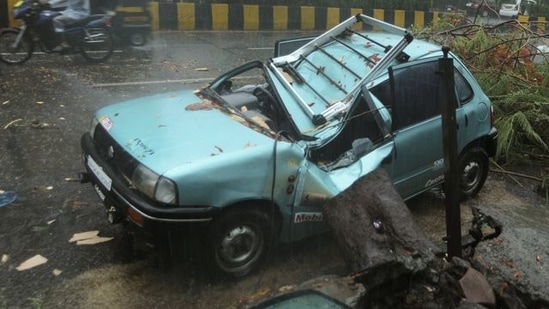Cyclone Tauktae: Rapid intensity takes experts by surprise
Tauktae is in keeping with the trend of an increasing number of cyclones in the Arabian Sea. Time was when most of those affecting India were on the other side, in the Bay of Bengal. Scientists have no doubts as to why this is happening -- warmer seas on account of the climate crisis.
Tauktae wasn’t supposed to become an extremely severe cyclonic storm, but favourable conditions reigning in the Arabian Sea helped it become that -- once again highlighting the potential impact of the climate crisis on India.

Tauktae intensified from a very severe to an extremely severe cyclonic storm rapidly on Monday, taking weather experts and scientists by surprise. “Tauktae intensified very rapidly this morning. We did not state that it would intensify to an extremely severe cyclone in our forecast. But it did because of extremely favourable oceanic and atmospheric conditions,” said M Mohapatra, director general, India Meteorological Department (IMD).
While forecasting the trajectory of Tauktae at 2.20am on Monday, IMD said it would intensify into a very severe cyclonic storm and cross the Gujarat coast on May 18 (Tuesday). But, by 8.15 am, another IMD bulletin said Tauktae already intensified to an extremely severe cyclonic storm with a maximum wind speed of 180-190 kmph gusting to 210 kmph and that it would cross the Gujarat coast on Monday night.
Tauktae is in keeping with the trend of an increasing number of cyclones in the Arabian Sea. Time was when most of those affecting India were on the other side, in the Bay of Bengal. Scientists have no doubts as to why this is happening -- warmer seas on account of the climate crisis. “Rapid intensification of cyclones is a response to climate change and ocean warming, and cyclone forecast models have a hard time in picking them up. We need to incorporate this in forecast models and be prepared on the ground for future...,” said Roxy Mathew Koll, a climate scientist at the Indian Institute of Tropical Meteorology.
Tauktae also intensified very rapidly from a depression to a cyclone on Friday. “With Cyclone Tauktae, this will be the fourth consecutive year of a pre-monsoon cyclone over the Arabian Sea. This is also the third consecutive year when a cyclone has come very close to the west coast of India. Sea surface temperatures in Arabian Sea have increased rapidly during the past century and this has led to an increase in the frequency and intensity of cyclones in the Arabian Sea… global warming has presented us with new challenges... Improving the Indian Ocean Observing System and incorporating global warming signals in the weather models can help us tackle the challenges,” Koll added.
Still, some experts warned of this. “Conditions are extremely favourable for its (Tauktae’s) rapid intensification. Ocean heat potential is above normal; sea surface temperatures are 1-2°C above normal… We should be prepared,” Sunitha Devi, who studies cyclones at IMD, said on Thursday when a low pressure area formed over Arabian Sea.
“We are seeing very intense cyclones form over Arabian Sea, they also intensify rapidly... It happens because ocean heat content is higher and sea surface temperatures are also higher... Sometimes our models are able capture this but not always,” said M Rajeevan, secretary, ministry of earth sciences.
According to “Assessment of Climate Change over the Indian Region,” a report released by Union ministry of earth sciences last year, observations indicate that frequency of extremely severe cyclonic storms over the Arabian Sea has increased during the post-monsoon seasons of 1998–2018. Most models are projecting a higher sea surface warming in the Arabian Sea than the Bay of Bengal.
Koll said ocean warming has made some new challenges for weather agencies. “Cyclones are now intensifying rapidly since warm ocean waters act as fuel for them. Extremely severe cyclones like Fani and Amphan intensified from a weak to severe status in less than 24 hours due to warm ocean conditions. That gives us less time to be prepared...”
“Compared to the Bay of Bengal, there has always been a greater probability for a depression (a low-pressure system) forming over the Arabian Sea to intensify into a severe cyclonic storm or a stronger tropical cyclone. This climatological trend seems to be fuelled by the warming of the Arabian Sea and atmospheric support, which have triggered some powerful tropical cyclones such as Tauktae and Kyarr (2019),” said Akshay Deoras, Independent meteorologist and PhD researcher at the University of Reading, United Kingdom.
All Access.
One Subscription.
Get 360° coverage—from daily headlines
to 100 year archives.



HT App & Website







